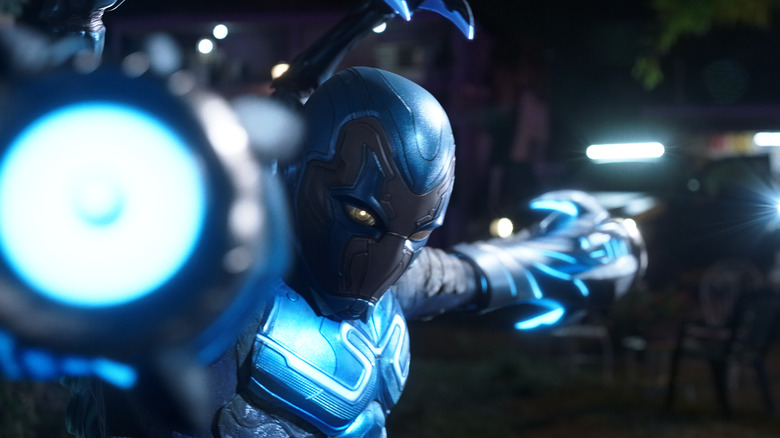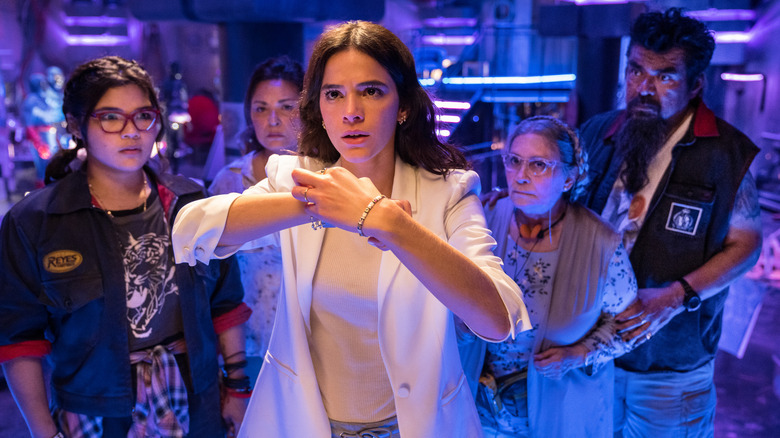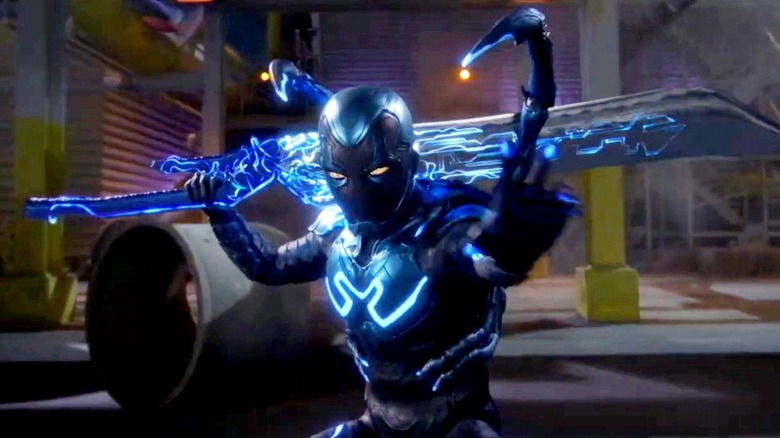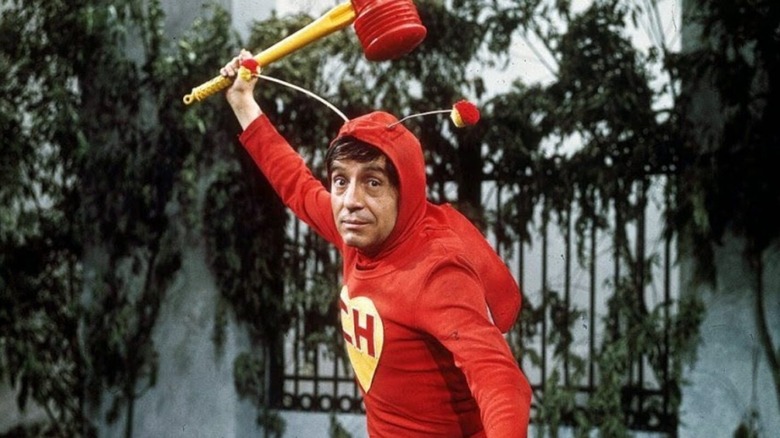The Blue Beetle Credits Scene Teases A Big Piece Of DC Comics History
This article contains major spoilers for "Blue Beetle."
The DC Universe has a new superhero in Jaime Reyes, the first Latino DC superhero, and a rare superhero whose entire family is a big part of their story. Family and the idea of legacy are big elements of the film, which explores the history of Mexican resilience in the Reyes family, and the future that Jaime represents.
That legacy also involves other Blue Beetle heroes, because even though they aren't a big part of the story, they offer something unique to the film. Though the Marvel Cinematic Universe is just now starting to explore the idea of legacy and the passing of the torch, shows like "Young Justice" have made a name for themselves by diving into the importance of legacy in the DC Universe. In "Blue Beetle," we learn that there have been two other heroes to use the name, inspired by the alien scarab that gives Jaime Reyes his powers — Dan Garrett and Ted Kord.
We learn that Garrett had also activated the scarab during his tenure as Blue Beetle, but Ted Kord was unable to, so he designed gadgets inspired by its technology instead. This is the same thing Ted's sister, Victoria (Susan Sarandon), does in creating the One Man Army Corp (OMAC) gear, devices that could turn any soldier into RoboCop. Of course, after a climactic battle, Victoria and the OMACs are destroyed, and Jaime fully embraces his powers and turns into a hero. However, while "Blue Beetle" is very self-contained and doesn't really connect to any specific DC Universe, it does plant the seeds for more stories, which could easily connect to the new DC Universe.
As is expected of a superhero movie, "Blue Beetle" has both a mid-credits and a post-credits scene, so let's dive into what happened and what it all means.
What's one superhero when you can have two?
Throughout the film, we hear and learn about Ted Kord, the previous owner of Kord Industries, who also just so happened to be an earlier version of Blue Beetle, who mysteriously disappeared years prior.
The credits scene takes us to Kord's secret Blue Beetle lair, with the camera zooming in on one of three mannequins, this one missing the Blue Beetle suit (implying he disappeared while on a super assignment). Then a computer monitor activates as Air Supply's song "All Out of Love" is heard playing before a recorded message breaks through. Turns out, Ted Kord is alive, and he wants his daughter Jenny to know he is alive and well. The scene smartly doesn't show the face of Ted Kord, making it easy to cast a big name in a potential sequel.
Interestingly enough, Ted doesn't specify where he is trapped (or when). This gives the new DCU an opportunity to bring to life one of the best superhero duos in comics. That's right, I'm talking about Blue & Gold — Blue Beetle and Booster Gold. We know Booster Gold is getting his own TV series as part of the DCU, and what better place to introduce Ted Kord than in that show? Booster Gold and Blue Beetle work because as strong as they are as heroes, they are also rather funny and low-key, they have odd jobs in addition to superheroes like being repo men one time.
What this could mean for the future of DC
It is also worth noting that both Blue Beetle and Booster Gold are a part of the Justice League International team from the '90s, one of the best versions of the team. The JLI was a more comedic, irreverent, and superbly weird version of the Justice League. Far from the pantheon of gods of the classic JLA, they were a bunch of egomaniacs, weirdos, and losers, but also lovable fools, just the kind of characters James Gunn excels at. Given Guy Gardner is set to appear in "Superman Legacy," there's a good chance we see some version of the JLI in the future of the DCU, whether with Ted Kord, or even with Jaime.
Also supporting this is the introduction of the OMACs in "Blue Beetle," cyborg one-man-army devices that turn any person into a deadly weapon. They were ultimately destroyed by the end of the film, but what if they weren't all destroyed? There has to at least be a patent or a blueprint out there, one that Bruce Wayne could acquire, and turn into the Brother Eye from the comics that he uses to spy on heroes. Without spoiling much, that storyline ties into the Justice League International, the death of a major hero, and ultimately to "Infinite Crisis," one of the biggest events in DC history, and a great idea for a big crossover for the DCU.
'More agile than a turtle! Stronger than a mouse!'
The post-credits scene for "Blue Beetle" is vastly different from the mid-credits scene. Following in the tradition of many other superhero movies, this is just a funny gag, referenced earlier in the movie. In the case of "Blue Beetle," it's a callback to a scene wherein Jaime's uncle Rudy (played by George Lopez) hacks into Kord Industries by flooding their security feeds with clips of a stop-motion animated version of the iconic Mexican superhero sitcom "El Chapulín Colorado." The show is a parody of superheroes, starring the titular Chapulín Colorado (the Red Grasshopper), a weak, clumsy hero with no powers, but whose heart of gold conquered generations of Latinos ever since the '70s.
Creator and star Roberto Gómez Bolaños once described the appeal of the character as a real hero by comparing it to American characters like Batman and Superman, saying El Chapulín is a true hero because he is not powerful or fearless. "Heroism is not about lacking fear, but overcoming it," he said in an interview. "El Chapulín Colorado is scared to death, he's clumsy, weak, silly, and he's aware of these flaws as he faces the problem."
"Blue Beetle" is all about legacy, so it is rather cool that the movie also pays homage to the original Mexican superhero.



